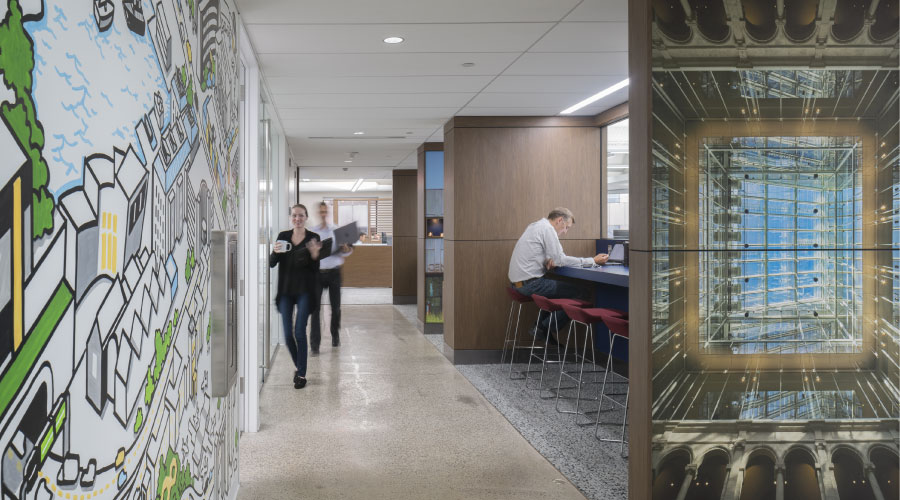Sounding Off on Open Office Plans and Workplace Acoustics
Much to the chagrin of most workers, the open office plan is here to stay. But there are many strategies facility managers can employ to mitigate distractions and make the office more inviting.
By Scott Hamilton, Contributing Writer
While pressure grows in some sectors for a more stringent return to office policy, a hybrid approach continues to be the preference for most workers. It appears, for the immediate future anyway, that the traditional five days per week 9-to-5 schedule is dead — or at least on life support.
Yet according to a recent survey by Resume Builder, 90 percent of companies responding say they will be implementing return-to-office requirements by the end of 2024. The argument from company leaders is that improved productivity, collaboration, and the fostering of a healthy company culture is only achievable through face-to-face, in-office interactions.
For most businesses, finding the balance between remote work and returning to the office will be challenging. Employers trying to entice workers back to the office are advised to look beyond quick fixes like providing free snacks, hosting happy hours, and offering ping-pong tables in the breakroom. A better investment is to focus on how they deal with sound to create a more welcoming environment. In short, companies will need to earn the commute whether it’s one day or five.
The following considers where we’ve been, how we got to this point, and where we’re headed—acoustically.
Distractions? Pick your chaos!
Working remote, often from home, led many to adopt new habits, new preferences, and new work requirements. At the same time, the traditional open office environment and its associated problems were lying dormant waiting for our return. When office doors finally reopened, many discovered that while nothing changed… everything changed.
For many, the pandemic lockdown transformed how and where we do business. The more fortunate enjoyed the luxury of spare rooms transformed into remote workspaces; they finally got a private office! Others were forced to set up shop in shared spaces with partners also working from home or with kids trying to attend online schools. And unlike online video conferences, real life doesn’t come with a mute button. These people are eager to escape children crying, dogs barking, and the many other distractions that can come with a chaotic home environment. In addition to the relative peace and order of the traditional office, these folks may have missed the daily social interaction they previously enjoyed with co-workers.
For others, return-to-office is far less attractive. For these folks, the forced social experiment of the past two years opened their eyes to the benefits of working from home. Many discovered a better work/life balance and more productive time formerly spent on daily commutes. These people are understandably hesitant to return to status quo of “business as usual” of the pre-COVID office.
Upon returning to the office, this group realized the one-size-fits-all rows of desks no longer meet their needs. Privacy is no longer a given. Freedom from distractions is no longer guaranteed. Maybe it’s the chatty neighbor talking loudly. Maybe it’s an office environment so quiet that every little noise or conversation seems amplified. The new normal is facing old problems. And most of these problems revolve around sound.
The continuing evolution of the open office.
The open office plan has a long and complex history in America. The origins of the open office can be traced back to the 19th century, when the industrial revolution led to the creation of large, factory-like office buildings. These early office spaces were typically designed to maximize efficiency and minimize costs. They often featured long rows of desks arranged in a large, open room. Think of the bustling newsrooms or the steno pool of busy typists depicted in movies.
Open office design has become more sophisticated. In the early 20th century, architects and designers began to experiment with different layouts and configurations, incorporating features such as cubicles and partitions to create a more flexible and adaptable workspace. By the mid-20th century, the open office had become the dominant office design in America, and it remains a popular choice for many organizations today. Company leaders are quick to cite the perceived benefits of open office design, including:
- improved collaboration and communication among employees creating an environment for increased productivity and creativity
- increased workspace flexibility and adaptability
- greater interaction and socialization among team members
- improved efficiency with ability to accommodate more employees in a limited space
- lower construction and fit out costs
Far too often, these observations are made from the doorway of the executive’s private office. When employees are asked their opinion, the benefits are far less clear. Drawbacks to open office design most often cited by those experiencing it firsthand include:
- reduced productivity and concentration resulting from increased noise and other distractions
- increased stress due to a lack of privacy and personal space
- employees in closer proximity to one another makes it easier to spread germs and illness
- the potential for increased conflict and decreased morale among employees
- the need for additional investment in sound masking technology and other equipment to mitigate distractions
How sound impacts performance, productivity, and health.
The challenges of the open office have been explored in numerous articles, op-ed columns, scientific journals — and exit interviews with unsatisfied employees. Until relatively recently, the answer to the question about productivity was subjective. Putting teams together with few physical barriers would intuitively lead to more spontaneous interactions, greater coordination on projects, and more communication overall. Recent studies, however, take a more quantitative look at the situation.
According to a study published by Management Review Quarterly, noise-induced distraction in open office plans is a recurring theme. Specifically, when speech intelligibility cannot be ensured, occupants experience anxiety, dissatisfaction, and a drop in performance. As the level of distractions increases, the result is increased stress and frustration levels. This leads to workers making more errors and a decrease in collaboration. Conversely, the report finds that lower perceived distraction fosters higher psychological comfort, enthusiasm, and satisfaction.
The National Center for Biotechnology Information cites a 14 percent drop in performance when a worker moves from a traditional office to an open activity-based workplace (ABW). However, moving from the nosier open space to a quiet office environment, cognitive performance increased significantly by 16.9 percent, and performance increased by 21.9 percent. The study emphasizes the importance for companies to provide optional areas or rooms free of distractions for employees working on tasks that demand greater concentration.
Making sound decisions for better office design.
Disagreement about the impact open office designs have on productivity aside, both pro and con lists shown above highlight the effect sound has on the individual and on communication dynamics overall. Good or bad, it appears the open office is here to stay. The question should not be about the merits of this workplace design, but rather how to make it work for everyone.
The ubiquitous use of headphones in today’s open offices illustrates how some individuals approach creating their own personal space. It is a solution some managers even encourage as they see the resulting increase in concentration and a drop in stress and frustration. The judicious use of headphones can be beneficial in certain situations where other mitigating measures are not possible. On the positive side, headphones can:
- help individuals prone to distraction in bustling open office setting better focus on their work by listening to familiar music to help them stay on task for longer periods
- serve as a signal to others that the wearer is busy and not open to unnecessary chit-chat
- reduce stress level by transporting listener to their “happy place” of soothing tunes.
There are risks to the use of headphones in the office setting as well, including:
- appearing antisocial or unprofessional to colleagues
- missing opportunities for spontaneous interactions with team members that can improve collaboration on tasks
- being disconnected from the day-to-day social structure of a community many of us spend most of our time in
- increasing friction between office neighbors who may feel ignored or irritated by the music escaping from your headset to the people around you.
Clear communication and agreement about the acceptable use of headphones by employees can help avoid many of these issues. Something as simple as posting a sign indicating openness to outside interactions such as, “Wearing earbuds, tap me if you need something,” or “I’ve got my headphones on, interrupt if important,” or even “I’m in the zone, interrupt me for emergencies only.” Limiting the use of these devices to times when they are absolutely necessary will also help.
In many instances, however, applied sound dampening or masking measures can be engineered to reduce or eliminate the need to don the headgear. Consulting with a qualified acoustics expert can be a great first step in solving problems before they happen.
In addition to sound masking, a careful study of office space layout and the location of individuals can help address perceived sound issues and other problems cited in open office environments. Such an examination could reveal the need for:
- more communal spaces that encourage formal and informal gatherings of workers to share interaction
- separate office spaces that can be reserved and used when a quiet area free from distractions is needed to successfully complete a specific task
- zoned areas that group workers with similar noise and distraction tolerances
- phone booth rooms that allow individuals a place for private or confidential conversations.
Unfortunately, there is no off-the-shelf, one size fits all solution to creating the perfect office environment. There is no single answer to how a space should be designed. Much is based on the culture of the organization and its members. Whatever the layout, however, sound design is a crucial element.
My sound opinion as an acoustics professional.
Office design will continue to evolve and attention to acoustics will play a growing role. The two-plus years away from the traditional office has given many employees the time to reflect upon and understand what they want. A competitive labor market is giving them leverage to push company leaders to listen to their needs.
The future office needs to be a place that offers and supports all the things we missed during lockdown — face to face interactions, team bonding, mentoring opportunities, spontaneous collaboration sessions, and the serendipity of new ideas sparked by unplanned conversations. Building owners and company leaders have a unique opportunity to reimagine these spaces to be as welcoming, healthy, and supportive as possible. Paying attention to acoustics will play a big part in these improvements.
Scott Hamilton is a senior project manager in acoustics for ESD, now Stantec Consulting Services. He has extensive experience working with acoustics and has successfully managed numerous projects, including data centers, concert halls, universities, healthcare facilities and major league baseball stadiums. Scott is a member of the Acoustical Society of America (ASA).
Related Topics:












